This blog post originally appeared on the PR 20/20 blog.
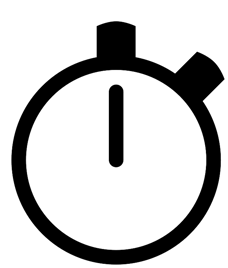 I spent the first six years of my marketing agency career chasing hourly quotas instead of results. Our goal was to bill a minimum of five hours per day.
I spent the first six years of my marketing agency career chasing hourly quotas instead of results. Our goal was to bill a minimum of five hours per day.
Yes, we cared if the client was happy and successful, but the fundamental economic driving force behind the firm’s existence, and my career potential, was the billable hour.
I discovered early on that the billable-hour model was a flawed, archaic, agency-centric system that wrongly tied agency performance to outputs, not outcomes.
In 2004, four years into my career, I became highly motivated to build a more efficient and profitable solution that shifted the focus to client needs and goals.
The idea was centered on making services tangible with clearly defined costs, features and benefits, almost like buying a product off a retail shelf or signing up for a software service.
My theory was that if clients understood exactly what they were getting, and agreed ahead of time what it was worth, then we could remove the mystery from the equation and focus on delivering value and results.
The problem was that the billable-hour model was the only one I had ever known. How would I build an entirely new financial model and productize a service business?
In Search of Our Value Metric
As I wrote in The Marketing Agency Blueprint, the guiding principle was that prices had to be value based, meaning they were to be determined based on perceived and actual value rather than the number of billable hours something takes to complete.
>> For more on the flaws of the billable hour model, read this 2012 post on Marketing Agency Insider.
But when The Marketing Agency Blueprint was published in December 2011, we hadn’t “cracked the code.” We had used some variation of standardized services and set pricing since our founding, but we struggled to find a single value metric upon which to build a new model.
A value metric is a pricing unit that aligns with the value you create for customers. If you sell something simple and tangible like an egg, then your value metric is an egg. If you sell software, then you find a metric that conveys an increase in value as customers increase their usage of the product.
For example, HubSpot’s value metric is number of contacts, Zapier’s is zaps, Wistia’s is videos, and Asana’s is members. The more you pay, the more of the value metric you get, and, in theory, the more value you get out of the product. Seems easy enough.
However, if you sell professional services, and you don’t believe hours are the answer, then the value metric isn’t quite so obvious.
Evolution of PR 20/20’s Pricing Model
In the 2006 version of PR 20/20’s original pricing guide there were 105 services within 19 categories. The full guide was available online with descriptions and set prices for every service. In essence, it was an a la carte menu that enabled marketers to choose the services they needed. It took 600+ hours of my life to create, but, honestly, it was just too complex with too many pricing variables. It was, however, an important first step in the process.
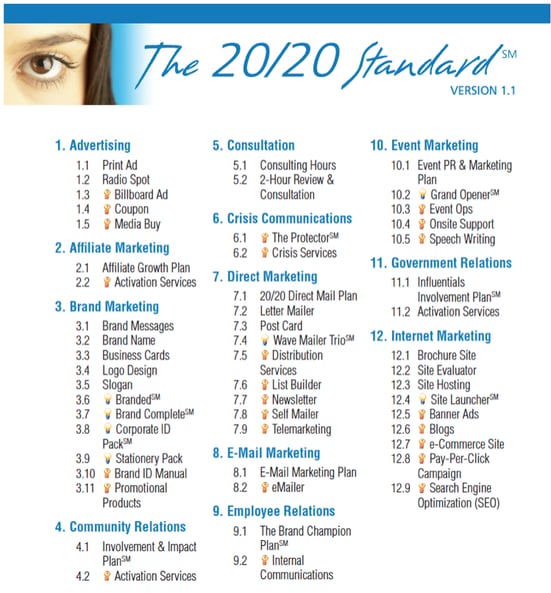
2008
In 2008, we introduced inbound marketing service packages primarily designed for HubSpot customers looking to outsource their marketing. These packages were an interesting evolution, but they were too tactical in nature and included more than a dozen standard value metrics (e.g. blog posts, lead forms, landings pages, keywords, etc.). Plus, they weren’t profitable for the agency and didn’t translate to the kind of results we wanted for clients. It was on to the next iteration.
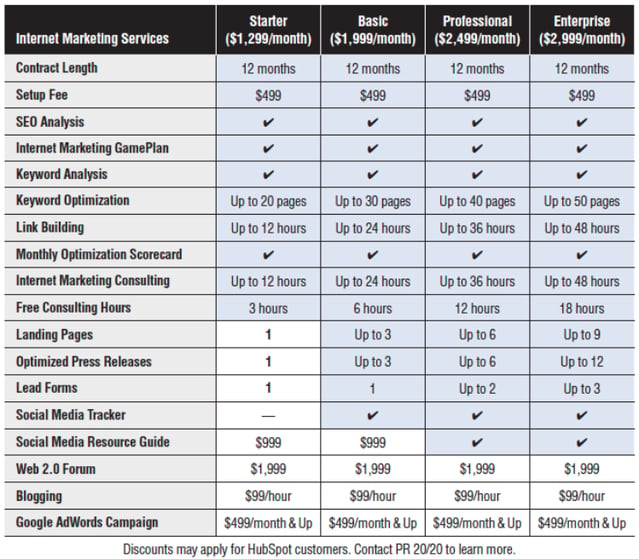
2010
In 2010, we made our first attempt at bundling content marketing services. The packages included standard allotments of blog posts and premium content word count that could be used for website copy, case studies, white papers, press releases, by-lined articles, ebooks and more. These packages also featured blocks of hours. Again, too many value metrics, and we hadn’t solved how to eliminate hours completely from the equation.

2012
Then, in late 2012, we conceived of using points. The idea was partially inspired by my interest at the time in agile software development, and heavily influenced by my love for sports.
I wanted something that felt different, but wasn’t too abstract to understand. I envisioned a pricing mechanism that subconsciously conveyed that marketing dollars were an investment, not an expense, and that every dollar spent had a purpose and represented incremental progress toward a goal.
It took more than 12 months to build and test the financial and operational models (e.g. time tracking, project management, invoicing, etc.) needed to convert the agency to points, and then we began methodically rolling it out to clients in January 2014.
Point PricingTM was born.
Anatomy of the Point Pricing Model
A point is a fixed unit of value. It’s PR 20/20’s value metric.
Point Pricing ensures clients get the full value of every dollar spent, regardless of how much time it takes to deliver. Points provide total transparency into pricing, progress, performance and resource allocation.
Each project within a campaign is assigned a fixed-point total (e.g. blog post = 3 points) based on value creation rather than hourly estimates. The point totals are standard across all clients and are determined using the Fibonacci sequence.
Wait, the what?
 The Fibonacci sequence represents a set of numbers that increases roughly based on a fixed ratio of 1.618, also known as The Golden Ratio. Each subsequent number is the sum of the previous two—1, 2, 3, 5, 8, 13, 21, 34, 55 . . .
The Fibonacci sequence represents a set of numbers that increases roughly based on a fixed ratio of 1.618, also known as The Golden Ratio. Each subsequent number is the sum of the previous two—1, 2, 3, 5, 8, 13, 21, 34, 55 . . .
Humans in general can’t accurately predict the hours it takes to complete a task due to variables such as professional competency, focus, efficiency and forecaster bias. When we try to forecast time to complete an activity, the higher the number, the more uncertain the forecast becomes.
The Fibonacci sequence accounts for this uncertainty. So rather than debating whether something is worth 8, 9, 10, 11, 12 or 13 points, in our world it’s either an 8 or a 13. And since clients have access to a standard point list, and we build points into their monthly GamePlansTM, they know exactly what every project costs, and how those points are designed to achieve their goals.
Let me show you how it works:
Service Packages
Our pricing page includes four standard packages. Each package costs $150/point (we recently changed this from a tiered-rate model). However, the more you invest each month, the more points and value-added features you get.
For example, clients at the Enterprise level get weekly Google Analytics reports at no additional cost that our team generates using artificial intelligence. We’re also able to offer extra points and discounts for workshops, referrals, add-on projects and contract renewals.
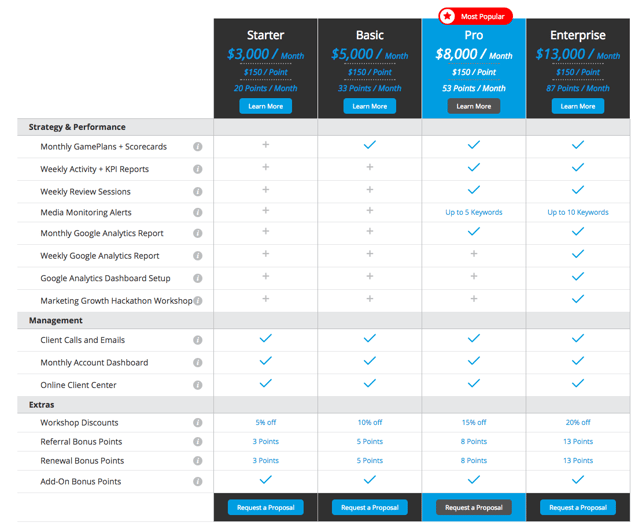
Sample 12-Month Allocation by Campaign
We also use points to forecast potential resource allocations when talking with prospective clients. This chart enables us to visualize a preliminary model by month and by campaign. Actual point allocation is determined during strategy sessions and then continually adjusted based on performance data and evolving client goals.
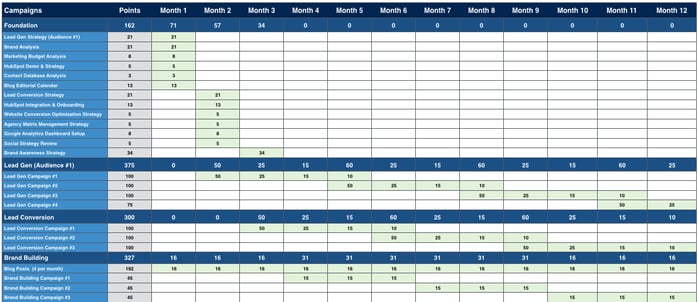
Sample 100-Point Campaign
As you see in the 12-month chart above, we have preliminary allocations of 100 points per lead generation campaign. So what does 100 points get you? Here’s an example.
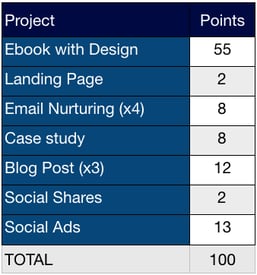
GamePlans
Every client has access to a shared Google Sheets workbook that includes monthly GamePlan tabs. The GamePlans are organized by campaigns and projects with columns for point totals, percent of project complete and project owners. The workbooks also include client dashboards that show resource allocation and performance by campaign.
>> How far does a point go? Download a Sample 300-Point Campaign Template <<
The Impact and Spread of Points
We’ve gone through dozens of pricing-model iterations since I first started pursuing a better way back in 2004. We’re still very early in the evolution of Point Pricing, but we can already see positive impact on efficiency, productivity, accountability, transparency and, most importantly, client performance.
Other agencies have begun shifting to points, and HubSpot is even advocating for the adoption of a point-based pricing system within its growth driven website design training program. Hopefully as the industry gradually shifts away from billable hours and other more opaque, agency-centric pricing models, we can collectively progress toward true value-based pricing.
Interested in Point Pricing?
Contact us any time to learn more about Point Pricing, and how it could be used to accelerate your organization’s performance.
Point Pricing is a trademark of PR 20/20, and all provided Point Pricing materials, including GamePlans and any other provided content, are the intellectual property of PR 20/20, protected by copyright law and other U.S. intellectual property laws. You must have our written permission to duplicate or use the Point Pricing trademarks, GamePlans, or any other provided Point Pricing content or materials for the benefit of any third party. If you have indicated an interest in a license arrangement with PR 20/20 for Point Pricing, we will provide you with all legal terms and conditions of use of our trademarks, content, and other protected intellectual property before entering into a license with you.
